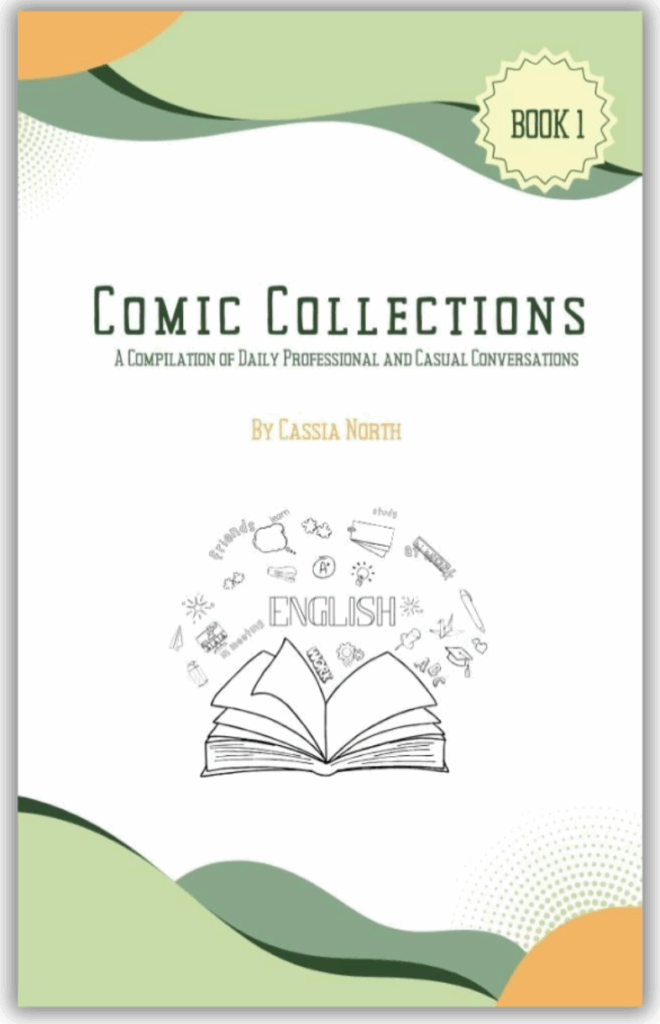
Common English Errors Blogs
"Let's Learn, Explore, and Connect to the World"

Then vs. Than: Quick Tips to Never Get Them Mixed Up Again
- Patricia Santos
- Common English Errors

Introduction
 The words “then” and “than” are among the most commonly confused terms in the English language. While they sound quite similar, these words perform distinct functions and are not interchangeable. Misusing them can lead to misunderstandings and diminish the clarity of your communication. “Then” generally relates to time and sequence, whereas “than” is used in comparisons. Such distinctions are crucial in both spoken and written English, as they can significantly impact the meaning of your statements.
The words “then” and “than” are among the most commonly confused terms in the English language. While they sound quite similar, these words perform distinct functions and are not interchangeable. Misusing them can lead to misunderstandings and diminish the clarity of your communication. “Then” generally relates to time and sequence, whereas “than” is used in comparisons. Such distinctions are crucial in both spoken and written English, as they can significantly impact the meaning of your statements.
 Understanding the proper use of “then” and “than” not only enhances your language accuracy but also boosts your confidence in writing and everyday conversations. This blog aims to clarify these differences with simple explanations and practical tips, ensuring you never mix them up again. Let’s dive into the specifics of each word to help cement your understanding and use of these frequently muddled terms.
Understanding the proper use of “then” and “than” not only enhances your language accuracy but also boosts your confidence in writing and everyday conversations. This blog aims to clarify these differences with simple explanations and practical tips, ensuring you never mix them up again. Let’s dive into the specifics of each word to help cement your understanding and use of these frequently muddled terms.
Exploring 'Then'
The word “then” functions mainly as an adverb, playing a critical role in expressing temporal relations and sequences in sentences. Its usage is essential for providing clarity about the order of events or the flow of logic, especially in narrative and expository writing.
Temporal Usage:
“Then” indicates a specific time in the past or future or a sequence in time. It helps in setting the timeline of events. For example:

“We saw the storm approaching; we then hurried indoors.”

“Back then, we didn’t have the technology we do today.”
In each example, “then” places actions or states in time, helping to paint a clear picture of when things occurred or will occur.
Sequential Usage:
Beyond temporal sequencing, “then” is often used to link a series of actions or logical steps. It can be instrumental in guides or instructions, providing a step-by-step progression:

“Mix the sugar and flour, then add the eggs.”

“Complete your homework; then you can watch television.”
Here, “then” doesn’t just denote time; it also indicates what comes next in a process or argument, showing consequence or progression.
Conditional Usage:
“Then” is frequently used in conditional sentences to denote the result of a condition being met. This usage is common in if-then constructs, a staple in logical reasoning and everyday decision-making:

“If you save enough money, then you can buy a new car.”

“If it rains tomorrow, then we will have to cancel the picnic.”
Each example uses “then” to introduce the outcome dependent on a preceding condition, emphasizing the cause-and-effect relationship.
Less Common Uses:
Although less frequent, “then” can serve as an adjective, typically in phrases like “the then-president” where it describes someone or something as it was at a specific time:

“The then-president addressed the nation during the crisis.”
In this role, “then” helps specify a particular historical or personal phase, providing context that is temporally bound.
Usage in Everyday Language:
In casual conversation and writing, “then” often appears in expressions that underscore conclusions or summarizations:

“Well, if that’s the case, then what are we waiting for?”

“So, what happens then?”
These uses of “then” are more fluid but still fundamentally tied to its core function of marking time or sequence.
Understanding the versatile roles “then” can play enhances one’s ability to clearly articulate sequences, conditions, and timelines, making narratives and arguments both compelling and logically coherent. Its correct usage is pivotal in ensuring that the intended temporal and logical relations are conveyed without ambiguity.
Exploring 'Than'
“Than” is a conjunction used exclusively for making comparisons between two or more elements. It plays a crucial role in constructing comparative sentences, which are fundamental to describing differences in characteristics, quantities, or qualities. Understanding how to use “than” correctly can greatly enhance clarity and precision in communication.
Basic Comparative Usage:
The primary function of “than” is to introduce the second part of a comparison. This word helps establish a relationship that highlights differences between the compared entities. For instance:

“He is taller than I am.”

“This book is more interesting than the one I read last week.”
In each example, “than” is used to directly compare two different subjects, emphasizing how one differs from the other in specific aspects.
Comparative Constructions:
“Than” is commonly found in sentences featuring comparative adjectives and adverbs, such as “better,” “smarter,” “faster,” “more,” and “less.” These constructions allow for nuanced expressions of comparison:

“She runs faster than her brother.”

“You are more dedicated than anyone else I know.”
These sentences not only compare two entities but also specify the dimension along which they are being compared, facilitated by “than.”
Complex Comparative Structures:
“Than” can also be used in more complex grammatical constructions involving implied elements or ellipses, where parts of the comparison are omitted because they are understood from context:

“I would rather go for a walk than (go to) a movie.”

“She likes you more than (she likes) me.”
Here, “than” still functions to denote comparison, but parts of the sentence are left unsaid, as they can be inferred by the reader or listener.
Errors and Misuses:
A common mistake in using “than” arises when it is confused with “then.” Misplacing these can completely alter the meaning of a sentence, as one dictates time or sequence and the other denotes comparison:

Incorrect: “I am more interested in reading then watching TV.”
Correct: “I am more interested in reading than watching TV.”
The incorrect sentence mistakenly uses “then,” suggesting a sequence of activities, while the correct usage of “than” indicates a preference between two options.
Importance in Everyday Language:
 In everyday speech and writing, maintaining the correct use of “than” is vital for articulating preferences, opinions, and comparative facts accurately. Whether discussing personal preferences, making professional recommendations, or engaging in academic writing, the ability to compare effectively is indispensable, making “than” a fundamental tool in the arsenal of effective communication.
In everyday speech and writing, maintaining the correct use of “than” is vital for articulating preferences, opinions, and comparative facts accurately. Whether discussing personal preferences, making professional recommendations, or engaging in academic writing, the ability to compare effectively is indispensable, making “than” a fundamental tool in the arsenal of effective communication.
By mastering the use of “than” for comparisons, speakers and writers can ensure that their messages about differences and preferences are clear and effectively understood.
Common Mistakes and Misuses
The confusion between “then” and “than” is a frequent issue in both written and spoken English, often leading to misunderstandings and errors in communication. Understanding these common mistakes can help clarify when to use each word correctly and improve overall language accuracy.
- Misunderstanding the Functions:
One of the most prevalent errors involves using “then” when “than” is required, and vice versa. This mistake typically stems from a misunderstanding of their functions—where “then” deals with time or sequence, and “than” is used for making comparisons.

Incorrect: “She is smarter then he is.”
Correct: “She is smarter than he is.”
In the incorrect example, “then” incorrectly implies a sequence, which does not make sense in the context of comparing intelligence. Using “than” correctly establishes the intended comparison.
Pronunciation Similarities:

The similar pronunciation of “then” and “than” often contributes to their confusion. In some dialects, these words might sound nearly identical, especially in fast speech, leading to errors in writing when these spoken habits carry over.
Overcorrection:
Sometimes, awareness of the common misuse of these words can lead to overcorrection, where individuals might replace “then” with “than” unnecessarily or vice versa, especially when they are unsure of the correct usage.

Incorrect: “If you want to go faster than, you need to practice.”
Correct: “If you want to go faster, then you need to practice.”
The incorrect sentence uses “than” in a scenario that requires “then” to indicate the consequence of the condition (wanting to go faster).
Conditional Sentences:
Errors often occur in conditional sentences, where the outcome or consequence is mistakenly introduced with “than” instead of “then.”

Incorrect: “If it rains, than we will stay indoors.”
Correct: “If it rains, then we will stay indoors.”
Using “than” in this context disrupts the meaning, as the sentence aims to establish a sequence of events based on a condition, which is the appropriate role for “then.”
Comparisons and Preferences:
Mistakes also frequently appear in expressions of preference or comparative assessments, where “than” is sometimes replaced with “then.”

Incorrect: “I would rather spend time with friends then work late.”
Correct: “I would rather spend time with friends than work late.”
Here, the misuse of “then” changes the intent from comparing two alternatives to suggesting a sequence of actions.
Enhancing Clarity:
To avoid these common mistakes, it’s crucial to reinforce the distinct roles of “then” and “than.” “Then” should always relate to time and sequence, while “than” should be reserved exclusively for comparisons. Recognizing the context in which each word is used will help prevent these errors and enhance clarity in communication. By focusing on these details, users can enhance both their comprehension and their use of these often-misunderstood words.
Tips for Remembering the Differences
Association with Similar Words:

- Then: Associate “then” with time. Both “then” and “time” start with the letter ‘T’. Whenever you’re discussing events in time or a sequence, think of “then.”
- Than: Link “than” to comparison; both “than” and “comparison” contain the letter ‘A’. Use “than” when comparing one thing to another.
Expand the Sentence:

- To check if “then” is the correct word, expand the sentence to include “at that time” or “next.” If the sentence still makes sense, “then” is likely correct.
- To test “than,” try expanding the comparison. For instance, replace “than” with “compared to.” If the sentence maintains its meaning, “than” is the right choice.
Practice Simple Sentences:

- Create simple practice sentences using “then” and “than.” For example, “I will eat, then I will study,” and “I am taller than my sister.” Practicing these can reinforce their uses.
Proofreading and Context Checks:

- Always proofread your writing for “then” and “than.” Ensuring you’ve used the correct word according to the context can save you from common mistakes. Reading sentences aloud can also help determine if the usage sounds correct based on the sentence’s context.
Remembering these distinctions and practicing regularly can significantly improve your accuracy in using “then” and “than,” enhancing both your written and spoken English skills.
Importance of Correct Usage in Professional and Academic Writing
 The precision of language in professional and academic contexts cannot be overstressed, and the correct use of “then” versus “than” is a quintessential part of this precision. Misusing these words can undermine the credibility of your communication, potentially leading to misinterpretations of your messages or assessments of your attention to detail.
The precision of language in professional and academic contexts cannot be overstressed, and the correct use of “then” versus “than” is a quintessential part of this precision. Misusing these words can undermine the credibility of your communication, potentially leading to misinterpretations of your messages or assessments of your attention to detail.
 In academic writing, clarity and accuracy are paramount. Using “then” when “than” is needed—or vice versa—can confuse readers and distract from the content’s strength. For instance, an incorrect sentence like “The results of the study were more significant then those of previous studies” misleads the reader into thinking about a sequence rather than a comparison, which can obscure the importance of the findings.
In academic writing, clarity and accuracy are paramount. Using “then” when “than” is needed—or vice versa—can confuse readers and distract from the content’s strength. For instance, an incorrect sentence like “The results of the study were more significant then those of previous studies” misleads the reader into thinking about a sequence rather than a comparison, which can obscure the importance of the findings.
 Similarly, in professional settings, such as business reports, presentations, or emails, clear communication helps to build trust and respect between colleagues and clients. An error involving “then” or “than” might seem minor, but it can detract from the overall professionalism of the document or correspondence.
Similarly, in professional settings, such as business reports, presentations, or emails, clear communication helps to build trust and respect between colleagues and clients. An error involving “then” or “than” might seem minor, but it can detract from the overall professionalism of the document or correspondence.
Taking the time to ensure correct usage of “then” and “than” reflects well on your professional image and academic integrity, reinforcing your reputation as a careful, precise thinker and communicator. Thus, mastering these details can significantly impact the effectiveness and professionalism of your writing.
Conclusion
 Grasping the distinctions between “then” and “than” is vital for clear and effective communication in English. “Then” relates to time and sequence, whereas “than” is used solely for comparisons. Incorrect use of these words can cause confusion and undermine the credibility of your writing. By employing the tips and strategies discussed, such as associating each word with a key concept and practicing with simple sentences, you can greatly enhance your linguistic precision. Always remember to proofread your work for these common errors. Learning to use “then” and “than” correctly will not only enhance your writing skills but also increase your confidence in everyday communication.
Grasping the distinctions between “then” and “than” is vital for clear and effective communication in English. “Then” relates to time and sequence, whereas “than” is used solely for comparisons. Incorrect use of these words can cause confusion and undermine the credibility of your writing. By employing the tips and strategies discussed, such as associating each word with a key concept and practicing with simple sentences, you can greatly enhance your linguistic precision. Always remember to proofread your work for these common errors. Learning to use “then” and “than” correctly will not only enhance your writing skills but also increase your confidence in everyday communication.
References
- Than vs. Then: Mastering the Key Difference for Fluent English Writing. (n.d.). ESLBUZZ. https://www.eslbuzz.com/than-vs-then/
- Common Mistakes in English and How to Avoid Them. (n.d.). Question and Answer English Online. https://qazdo.com/english-for-everyone/common-mistakes-in-english-and-how-to-avoid-them/
Latest Blogs

Present Simple Continuous 1
English Blogs “Let’s Learn, Explore, and Connect to the World” Present Simple Continuous 1 I. Introduction to the Present Continuous Tense in English The present

The Impact of Technology on Mental Health: Balancing Digital and Real Life
Mental and Emotional Health “Let’s Learn, Explore, and Connect to the World” The Impact of Technology on Mental Health: Balancing Digital and Real Life Introduction
Reading comprehension quiz
Check out our books and more!

Travel English: A Compilation of Key English Conversations When Traveling
Explore the world confidently with ‘Travel English’ by Allison Kate, a comic-style guide full of essential conversations and tips for every traveler. Speak English with ease in airports, hotels, and more!
Check out our Blogs!
Read our everyday blogs and gain new knowledge, skills, and inspiration to support your learning journey here in SEKAEL.


Explore English Blogs to improve your speaking, listening, reading, and writing skills in real-life situations.







 Many people think of soldiers when they hear about PTSD, but it can actually affect anyone. Scary and dangerous situations, like a horrible accident, a terrible natural disaster, or a violent crime, can trigger PTSD. The disorder can profoundly impact an individual’s daily life, influencing their emotional state, relationships, and overall ability to function.
Many people think of soldiers when they hear about PTSD, but it can actually affect anyone. Scary and dangerous situations, like a horrible accident, a terrible natural disaster, or a violent crime, can trigger PTSD. The disorder can profoundly impact an individual’s daily life, influencing their emotional state, relationships, and overall ability to function.







 Post-Traumatic Stress Disorder (PTSD) manifests through a complex array of symptoms that can significantly impair an individual’s daily functioning and quality of life. People with PTSD experience symptoms in four main ways: reliving the event, avoiding reminders, negative thoughts and feelings, and feeling jumpy or on edge. Recognizing these signs early is key to getting effective treatment for PTSD.
Post-Traumatic Stress Disorder (PTSD) manifests through a complex array of symptoms that can significantly impair an individual’s daily functioning and quality of life. People with PTSD experience symptoms in four main ways: reliving the event, avoiding reminders, negative thoughts and feelings, and feeling jumpy or on edge. Recognizing these signs early is key to getting effective treatment for PTSD.








 The treatment and healing journey for those suffering from Post-Traumatic Stress Disorder (PTSD) is often multifaceted, involving various strategies and approaches to manage symptoms and facilitate recovery. Effective treatment plans are typically personalized, taking into account the individual’s specific symptoms, experiences, and needs. Here’s a detailed look at the most effective treatment options and healing approaches for PTSD:
The treatment and healing journey for those suffering from Post-Traumatic Stress Disorder (PTSD) is often multifaceted, involving various strategies and approaches to manage symptoms and facilitate recovery. Effective treatment plans are typically personalized, taking into account the individual’s specific symptoms, experiences, and needs. Here’s a detailed look at the most effective treatment options and healing approaches for PTSD:


 4. Support Systems:
4. Support Systems: Holistic Approaches:
Holistic Approaches:



 Understanding PTSD is essential for providing support to those affected and for fostering resilient communities. By recognizing the causes, symptoms, and effective treatments, we can better assist individuals in navigating their healing journeys. This guide underscores the importance of early intervention, tailored treatment plans, and ongoing support to manage PTSD. Awareness and education are key to reducing stigma and promoting timely and effective care. As we continue to learn more about PTSD, it’s crucial that we remain committed to advancing treatment approaches and support systems, ensuring that every individual has the opportunity to recover and thrive after experiencing trauma.
Understanding PTSD is essential for providing support to those affected and for fostering resilient communities. By recognizing the causes, symptoms, and effective treatments, we can better assist individuals in navigating their healing journeys. This guide underscores the importance of early intervention, tailored treatment plans, and ongoing support to manage PTSD. Awareness and education are key to reducing stigma and promoting timely and effective care. As we continue to learn more about PTSD, it’s crucial that we remain committed to advancing treatment approaches and support systems, ensuring that every individual has the opportunity to recover and thrive after experiencing trauma.



 In the modern era, mental health issues have escalated into a significant global challenge, impacting countless individuals worldwide. Anxiety, depression, and stress-related disorders are increasingly prevalent, prompting a search for effective treatments beyond traditional medication and psychotherapy. One promising area of exploration is the impact of physical exercise on mental well-being.
In the modern era, mental health issues have escalated into a significant global challenge, impacting countless individuals worldwide. Anxiety, depression, and stress-related disorders are increasingly prevalent, prompting a search for effective treatments beyond traditional medication and psychotherapy. One promising area of exploration is the impact of physical exercise on mental well-being. This blog post delves into the scientific underpinnings of exercise’s impact on mental health, exploring how it can be a powerful tool not only for treatment but also for prevention of mental health problems. By examining both the biological and psychological mechanisms at play, we aim to shed light on why incorporating exercise into daily routines can be a transformative strategy for enhancing mental well-being.
This blog post delves into the scientific underpinnings of exercise’s impact on mental health, exploring how it can be a powerful tool not only for treatment but also for prevention of mental health problems. By examining both the biological and psychological mechanisms at play, we aim to shed light on why incorporating exercise into daily routines can be a transformative strategy for enhancing mental well-being. Mental health involves our emotional, psychological, and social well-being, influencing our everyday thoughts, feelings, and behaviors. It is vital in how we handle stress, relate to others, and make decisions. Essential to our existence, mental health is crucial for sustaining a high-quality life.
Mental health involves our emotional, psychological, and social well-being, influencing our everyday thoughts, feelings, and behaviors. It is vital in how we handle stress, relate to others, and make decisions. Essential to our existence, mental health is crucial for sustaining a high-quality life.








 While the therapeutic benefits of exercise for existing mental health conditions are well documented, its role in preventing the onset of such disorders is equally significant. Regular physical activity can serve as a proactive measure in maintaining mental health and preventing the development of mental health issues.
While the therapeutic benefits of exercise for existing mental health conditions are well documented, its role in preventing the onset of such disorders is equally significant. Regular physical activity can serve as a proactive measure in maintaining mental health and preventing the development of mental health issues.







 Although the advantages of exercise for mental health are well-established, beginning and adhering to an exercise regimen can be difficult for many people. Identifying and tackling the obstacles that hinder participation in physical activity is essential for effective implementation. Below are some typical barriers and methods to overcome them:
Although the advantages of exercise for mental health are well-established, beginning and adhering to an exercise regimen can be difficult for many people. Identifying and tackling the obstacles that hinder participation in physical activity is essential for effective implementation. Below are some typical barriers and methods to overcome them: Exercise goes beyond physical activity; it is a potent instrument for improving mental wellness and resilience. As we’ve explored throughout this blog, the benefits of exercise extend far beyond the physical realm, profoundly impacting mental health through biological, psychological, and social mechanisms. Whether it’s improving mood, boosting cognitive function, or acting as a preventative shield against stress and anxiety, the role of exercise in mental health care is unmistakable and strongly backed by scientific research.
Exercise goes beyond physical activity; it is a potent instrument for improving mental wellness and resilience. As we’ve explored throughout this blog, the benefits of exercise extend far beyond the physical realm, profoundly impacting mental health through biological, psychological, and social mechanisms. Whether it’s improving mood, boosting cognitive function, or acting as a preventative shield against stress and anxiety, the role of exercise in mental health care is unmistakable and strongly backed by scientific research. In conclusion, embracing exercise as part of your mental health strategy is not just about combating or preventing mental illness; it’s about nurturing overall wellness and quality of life. Whether you’re taking a brisk walk in the morning, joining a yoga class, or simply stretching during a break, each movement is a step toward a healthier, happier mind. Let’s continue to break down the barriers and uplift the spirits by harnessing the profound impact of exercise on mental health.
In conclusion, embracing exercise as part of your mental health strategy is not just about combating or preventing mental illness; it’s about nurturing overall wellness and quality of life. Whether you’re taking a brisk walk in the morning, joining a yoga class, or simply stretching during a break, each movement is a step toward a healthier, happier mind. Let’s continue to break down the barriers and uplift the spirits by harnessing the profound impact of exercise on mental health.








 Before embarking on your search for the right therapist, the first crucial step is to understand your own mental health needs. This self-assessment will help you locate a therapist whose expertise matches the particular issues you wish to tackle.
Before embarking on your search for the right therapist, the first crucial step is to understand your own mental health needs. This self-assessment will help you locate a therapist whose expertise matches the particular issues you wish to tackle.










 After identifying potential therapists, the next step is to confirm that they are well-suited to meet your needs. Vetting a therapist involves examining their credentials, experience, and approach to ensure they can provide the type of support you require.
After identifying potential therapists, the next step is to confirm that they are well-suited to meet your needs. Vetting a therapist involves examining their credentials, experience, and approach to ensure they can provide the type of support you require. Finding a therapist who is qualified and experienced is crucial, but equally important is ensuring a good personal fit. Therapy is a deeply personal process, and feeling comfortable and connected with your therapist significantly enhances the therapeutic experience and outcomes.
Finding a therapist who is qualified and experienced is crucial, but equally important is ensuring a good personal fit. Therapy is a deeply personal process, and feeling comfortable and connected with your therapist significantly enhances the therapeutic experience and outcomes. While finding a therapist who is a good match in terms of approach and compatibility is crucial, several practical considerations can influence your decision. These elements are crucial in making sure that the therapy process remains effective and sustainable over the long term.
While finding a therapist who is a good match in terms of approach and compatibility is crucial, several practical considerations can influence your decision. These elements are crucial in making sure that the therapy process remains effective and sustainable over the long term. Once you have gathered all the necessary information and evaluated your options, the final step is to make an informed decision about choosing your therapist. This decision is crucial as it sets the foundation for your therapeutic journey. Here are some guidelines to help you make the best choice:
Once you have gathered all the necessary information and evaluated your options, the final step is to make an informed decision about choosing your therapist. This decision is crucial as it sets the foundation for your therapeutic journey. Here are some guidelines to help you make the best choice: Choosing the right therapist is a pivotal step in your mental health journey. It requires careful consideration of your personal needs, therapeutic goals, and practical circumstances. By following the steps outlined in this guide—from understanding different therapeutic modalities to evaluating practical considerations and trusting your instincts—you can make an informed decision that best suits your individual situation. Remember, the relationship you build with your therapist is crucial for effective therapy. Take the time to find a professional who meets your expectations and provides the support and guidance you need to navigate your path to better mental health.
Choosing the right therapist is a pivotal step in your mental health journey. It requires careful consideration of your personal needs, therapeutic goals, and practical circumstances. By following the steps outlined in this guide—from understanding different therapeutic modalities to evaluating practical considerations and trusting your instincts—you can make an informed decision that best suits your individual situation. Remember, the relationship you build with your therapist is crucial for effective therapy. Take the time to find a professional who meets your expectations and provides the support and guidance you need to navigate your path to better mental health.




 In today’s rapid-paced society, anxiety has become a prevalent issue, impacting the daily lives and overall health of millions of individuals. With the hustle and bustle of modern living, finding calm and maintaining mental balance are more challenging than ever. Amidst numerous therapeutic approaches to manage anxiety, meditation has emerged as a particularly effective tool. Praised for its accessibility and lack of side effects, meditation offers a pathway to peace and resilience against stress.
In today’s rapid-paced society, anxiety has become a prevalent issue, impacting the daily lives and overall health of millions of individuals. With the hustle and bustle of modern living, finding calm and maintaining mental balance are more challenging than ever. Amidst numerous therapeutic approaches to manage anxiety, meditation has emerged as a particularly effective tool. Praised for its accessibility and lack of side effects, meditation offers a pathway to peace and resilience against stress. This blog will guide beginners through simple, step-by-step meditation techniques specifically tailored to alleviate anxiety. By demystifying meditation and providing practical advice, we aim to empower you to harness this powerful tool for anxiety relief and improved mental health.
This blog will guide beginners through simple, step-by-step meditation techniques specifically tailored to alleviate anxiety. By demystifying meditation and providing practical advice, we aim to empower you to harness this powerful tool for anxiety relief and improved mental health.





 Meditation reduces anxiety by changing the neural pathways in the brain, enhancing your resilience to stress. It lowers the stress hormone cortisol, improves concentration, and increases self-awareness, all of which play a critical role in managing anxiety symptoms. Over time, regular meditation practice can help diminish the intensity of anxiety attacks, increase emotional flexibility, and enhance overall well-being.
Meditation reduces anxiety by changing the neural pathways in the brain, enhancing your resilience to stress. It lowers the stress hormone cortisol, improves concentration, and increases self-awareness, all of which play a critical role in managing anxiety symptoms. Over time, regular meditation practice can help diminish the intensity of anxiety attacks, increase emotional flexibility, and enhance overall well-being.








 Incorporating meditation into your daily schedule is crucial to fully reap its benefits, especially for controlling anxiety. Here are some practical tips for making meditation a consistent and rewarding part of your life:
Incorporating meditation into your daily schedule is crucial to fully reap its benefits, especially for controlling anxiety. Here are some practical tips for making meditation a consistent and rewarding part of your life: Embracing meditation as a tool for anxiety relief can transform your approach to managing stress and enhancing well-being. By understanding different meditation techniques and incorporating them into your daily routine, you empower yourself with a powerful, accessible resource for calming the mind and soothing the body. Remember, the journey of meditation is personal and evolves over time. Consistency and patience are key—allow yourself to grow into the practice at your own pace. Each session provides a deeper understanding of how your mind operates, helping you handle life’s challenges with more ease and resilience.
Embracing meditation as a tool for anxiety relief can transform your approach to managing stress and enhancing well-being. By understanding different meditation techniques and incorporating them into your daily routine, you empower yourself with a powerful, accessible resource for calming the mind and soothing the body. Remember, the journey of meditation is personal and evolves over time. Consistency and patience are key—allow yourself to grow into the practice at your own pace. Each session provides a deeper understanding of how your mind operates, helping you handle life’s challenges with more ease and resilience.





 Homophones are words that sound the same but differ in meaning, spelling, or both, making them some of the trickier components of the English language to learn. The reason they cause confusion is primarily due to their similar sound, which can lead to errors in writing, especially when the nuances of their meanings are not well understood. These mistakes are not just common among learners of English but also occasionally trip up native speakers.
Homophones are words that sound the same but differ in meaning, spelling, or both, making them some of the trickier components of the English language to learn. The reason they cause confusion is primarily due to their similar sound, which can lead to errors in writing, especially when the nuances of their meanings are not well understood. These mistakes are not just common among learners of English but also occasionally trip up native speakers. Understanding and mastering the correct usage of homophones is crucial because they can significantly affect the clarity of communication. Misusing homophones can lead to misunderstandings and ambiguity in written texts. To use them correctly, it is essential to grasp their definitions and the context in which they are used. This understanding begins with exploring each homophone in detail, starting with the commonly mixed-up trio: “there,” “their,” and “they’re.”
Understanding and mastering the correct usage of homophones is crucial because they can significantly affect the clarity of communication. Misusing homophones can lead to misunderstandings and ambiguity in written texts. To use them correctly, it is essential to grasp their definitions and the context in which they are used. This understanding begins with exploring each homophone in detail, starting with the commonly mixed-up trio: “there,” “their,” and “they’re.”
 Furthermore, “there” can function as a noun, although this usage is less common. In this capacity, it refers to a state or condition, as in the phrase “getting from here to there.” This usage is more abstract and is often philosophical or reflective about the journey between two different states or conditions.
Furthermore, “there” can function as a noun, although this usage is less common. In this capacity, it refers to a state or condition, as in the phrase “getting from here to there.” This usage is more abstract and is often philosophical or reflective about the journey between two different states or conditions. The versatility of “there” can make it confusing, but the key to understanding its correct application lies in context. Whether indicating a location, introducing a sentence, or describing a state, “there” is always used to point out or declare something. It is never used to denote possession, which is where it often gets confused with “their.”
The versatility of “there” can make it confusing, but the key to understanding its correct application lies in context. Whether indicating a location, introducing a sentence, or describing a state, “there” is always used to point out or declare something. It is never used to denote possession, which is where it often gets confused with “their.” The word “their” is a possessive adjective used to indicate ownership or association belonging to some specific people or things previously mentioned or easily identified in the context. Unlike “there,” which relates to location or existence, “their” refers directly to possessions or associations with people, animals, or things. It always precedes a noun, modifying it to denote possession.
The word “their” is a possessive adjective used to indicate ownership or association belonging to some specific people or things previously mentioned or easily identified in the context. Unlike “there,” which relates to location or existence, “their” refers directly to possessions or associations with people, animals, or things. It always precedes a noun, modifying it to denote possession. The confusion often arises not from its usage but from its sound, which is homophonous with “there” and “they’re.” This can lead to errors in writing where one might incorrectly substitute “their” with one of these homophones. However, remembering that “there” is always used in contexts of ownership can help clarify its correct application.
The confusion often arises not from its usage but from its sound, which is homophonous with “there” and “they’re.” This can lead to errors in writing where one might incorrectly substitute “their” with one of these homophones. However, remembering that “there” is always used in contexts of ownership can help clarify its correct application. Because “their” addresses ownership, it is inherently plural, though it is also used singularly in cases respecting gender neutrality, such as in “Someone left their book on the table.” Here, “their” allows for an unspecified gender of the person who owns the book, aligning with contemporary efforts to use inclusive language.
Because “their” addresses ownership, it is inherently plural, though it is also used singularly in cases respecting gender neutrality, such as in “Someone left their book on the table.” Here, “their” allows for an unspecified gender of the person who owns the book, aligning with contemporary efforts to use inclusive language. “They’re” is a contraction of the words “they” and “are,” which serves as a straightforward way to streamline speech and writing. This form is typically used in informal settings and is very common in spoken English. It combines a pronoun and a verb, indicating a present action or state being experienced by multiple subjects.
“They’re” is a contraction of the words “they” and “are,” which serves as a straightforward way to streamline speech and writing. This form is typically used in informal settings and is very common in spoken English. It combines a pronoun and a verb, indicating a present action or state being experienced by multiple subjects. The contraction “they’re” can also describe a current state of being, as seen in “They’re happy with the results.” Here, it is used to express the emotions or conditions of the subjects at the moment. Contractions like “they’re” are particularly useful for making the language flow more naturally and mimicking spoken language in written form.
The contraction “they’re” can also describe a current state of being, as seen in “They’re happy with the results.” Here, it is used to express the emotions or conditions of the subjects at the moment. Contractions like “they’re” are particularly useful for making the language flow more naturally and mimicking spoken language in written form.








 Mastering the correct use of “there,” “their,” and “they’re” is essential for clear and effective communication in English. These homophones, while sounding identical, carry different meanings and serve unique functions within sentences. Misusing them can not only lead to confusion but also detract from the credibility of your writing.
Mastering the correct use of “there,” “their,” and “they’re” is essential for clear and effective communication in English. These homophones, while sounding identical, carry different meanings and serve unique functions within sentences. Misusing them can not only lead to confusion but also detract from the credibility of your writing. To avoid common pitfalls, it’s important to understand the distinct roles these words play. Remember: “there” indicates location or existence, “their” denotes possession, and “they’re” is a contraction for “they are,” used to describe actions or states of being. By applying the practical tips provided, such as using mnemonic devices, practicing with replacement, and diligent proofreading, you can reinforce their correct usage.
To avoid common pitfalls, it’s important to understand the distinct roles these words play. Remember: “there” indicates location or existence, “their” denotes possession, and “they’re” is a contraction for “they are,” used to describe actions or states of being. By applying the practical tips provided, such as using mnemonic devices, practicing with replacement, and diligent proofreading, you can reinforce their correct usage.








 The word “affect,” at first glance, might seem daunting due to its common confusion with “effect.” However, its usage and significance in the English language are clear and distinct once demystified. Primarily functioning as a verb, “affect” conveys the action of having an impact on or making a difference to someone or something. It’s about the influence that alters outcomes or states of being. Beyond its general application, “affect” holds a particular place in psychological contexts, where it can also emerge as a noun to describe emotions or desires that influence behavior.
The word “affect,” at first glance, might seem daunting due to its common confusion with “effect.” However, its usage and significance in the English language are clear and distinct once demystified. Primarily functioning as a verb, “affect” conveys the action of having an impact on or making a difference to someone or something. It’s about the influence that alters outcomes or states of being. Beyond its general application, “affect” holds a particular place in psychological contexts, where it can also emerge as a noun to describe emotions or desires that influence behavior.










 In psychology, “affect” frequently steps out of its usual role as a verb to become a noun, denoting an individual’s experience of feeling or emotion. Psychological “affect” is a crucial concept in understanding human behavior, as it encompasses a range of emotions from intense happiness to profound sadness. For example, a study might examine the “affect” of social media on teenagers’ self-esteem, focusing on emotional responses rather than the broader influence or outcomes.
In psychology, “affect” frequently steps out of its usual role as a verb to become a noun, denoting an individual’s experience of feeling or emotion. Psychological “affect” is a crucial concept in understanding human behavior, as it encompasses a range of emotions from intense happiness to profound sadness. For example, a study might examine the “affect” of social media on teenagers’ self-esteem, focusing on emotional responses rather than the broader influence or outcomes. In legal and scientific discourse, “effect” often takes center stage, particularly when discussing the consequences or outcomes of laws, policies, or experimental conditions. Legal documents may detail the “effects” of legislation on certain populations or industries, emphasizing the results of enacting specific laws. Similarly, in scientific research, discussing the “effects” of a new drug or treatment involves analyzing the results observed during clinical trials.
In legal and scientific discourse, “effect” often takes center stage, particularly when discussing the consequences or outcomes of laws, policies, or experimental conditions. Legal documents may detail the “effects” of legislation on certain populations or industries, emphasizing the results of enacting specific laws. Similarly, in scientific research, discussing the “effects” of a new drug or treatment involves analyzing the results observed during clinical trials. Understanding the context in which these words are used can greatly enhance clarity and precision in communication. For instance, legal and scientific professionals need to articulate the “effects” of their actions and findings accurately to inform, persuade, or document outcomes. In psychology, distinguishing between “affect” as an emotional response and “effect” as the outcome of interventions is critical for clear, effective communication.
Understanding the context in which these words are used can greatly enhance clarity and precision in communication. For instance, legal and scientific professionals need to articulate the “effects” of their actions and findings accurately to inform, persuade, or document outcomes. In psychology, distinguishing between “affect” as an emotional response and “effect” as the outcome of interventions is critical for clear, effective communication.
 The ability to distinguish between “affect” and “effect” transcends mere academic exercise. It empowers individuals to convey their thoughts with precision, enhancing the clarity and impact of their message. It fosters a deeper level of understanding and engagement among audiences, regardless of the setting.
The ability to distinguish between “affect” and “effect” transcends mere academic exercise. It empowers individuals to convey their thoughts with precision, enhancing the clarity and impact of their message. It fosters a deeper level of understanding and engagement among audiences, regardless of the setting. This exploration serves as a microcosm of the broader linguistic adventure. English, with its rich tapestry of nuances, invites continuous learning and curiosity. Each word, with its specific contours and shades of meaning, contributes to the vibrant mosaic of communication. Embracing the challenge of linguistic precision not only refines one’s ability to express complex ideas but also enriches the overall capacity for critical thinking and nuanced understanding.
This exploration serves as a microcosm of the broader linguistic adventure. English, with its rich tapestry of nuances, invites continuous learning and curiosity. Each word, with its specific contours and shades of meaning, contributes to the vibrant mosaic of communication. Embracing the challenge of linguistic precision not only refines one’s ability to express complex ideas but also enriches the overall capacity for critical thinking and nuanced understanding.
 In the landscape of communication, where clarity is king and precision its crown jewel, mastering the nuances of language opens doors to worlds of understanding and expression. Let us stride forward with confidence, armed with the knowledge to navigate the complexities of “affect” and “effect,” and eager to uncover the next linguistic treasure hidden within the folds of the English language.
In the landscape of communication, where clarity is king and precision its crown jewel, mastering the nuances of language opens doors to worlds of understanding and expression. Let us stride forward with confidence, armed with the knowledge to navigate the complexities of “affect” and “effect,” and eager to uncover the next linguistic treasure hidden within the folds of the English language.



 Lately, the link between nutrition and mental health has garnered significant interest from researchers, medical professionals, and the general public. This burgeoning field of study explores how what we eat directly affects the way we feel, think, and behave. Traditional diets, once evaluated solely for their physical health benefits, are now being scrutinized for their impact on mental well-being. As the global burden of mental health disorders continues to rise, understanding the potential of dietary strategies to alleviate symptoms of depression, anxiety, and other mental conditions is more crucial than ever.
Lately, the link between nutrition and mental health has garnered significant interest from researchers, medical professionals, and the general public. This burgeoning field of study explores how what we eat directly affects the way we feel, think, and behave. Traditional diets, once evaluated solely for their physical health benefits, are now being scrutinized for their impact on mental well-being. As the global burden of mental health disorders continues to rise, understanding the potential of dietary strategies to alleviate symptoms of depression, anxiety, and other mental conditions is more crucial than ever. This exploration is not merely academic; it has profound practical implications for daily living. The adage “you are what you eat” extends beyond physical health, suggesting that our food choices might influence our emotional and cognitive functions. This blog aims to unpack what current science says about the role of nutrition in mental health. By delving into how different nutrients, diets, and eating patterns affect mental health, we seek to provide insights that can help individuals make informed dietary choices for both physical and mental well-being. Join us in examining the intricate connection between our diet and mental health, supported by the newest scientific findings.
This exploration is not merely academic; it has profound practical implications for daily living. The adage “you are what you eat” extends beyond physical health, suggesting that our food choices might influence our emotional and cognitive functions. This blog aims to unpack what current science says about the role of nutrition in mental health. By delving into how different nutrients, diets, and eating patterns affect mental health, we seek to provide insights that can help individuals make informed dietary choices for both physical and mental well-being. Join us in examining the intricate connection between our diet and mental health, supported by the newest scientific findings. Mental health encompasses our emotional, psychological, and social well-being. It influences how we think, feel, and behave in daily life. It influences our stress management, our relationships with others, and our decision-making processes. Mental health is essential to our ability, both collectively and individually, to process thoughts, experience emotions, engage socially, work, and appreciate life. Consequently, the advancement, safeguarding, and recovery of mental health are critical concerns for individuals, communities, and societies worldwide.
Mental health encompasses our emotional, psychological, and social well-being. It influences how we think, feel, and behave in daily life. It influences our stress management, our relationships with others, and our decision-making processes. Mental health is essential to our ability, both collectively and individually, to process thoughts, experience emotions, engage socially, work, and appreciate life. Consequently, the advancement, safeguarding, and recovery of mental health are critical concerns for individuals, communities, and societies worldwide. With conditions such as depression and anxiety on the rise globally, understanding the underlying factors that contribute to mental health is more important than ever. Depression is a primary cause of disability around the world, impacting nearly 264 million people globally. Additionally, millions suffer from anxiety disorders, such as panic disorder, obsessive-compulsive disorder (OCD), and various phobias. These disorders can significantly impair an individual’s ability to function daily and can lead to profound personal and social consequences.
With conditions such as depression and anxiety on the rise globally, understanding the underlying factors that contribute to mental health is more important than ever. Depression is a primary cause of disability around the world, impacting nearly 264 million people globally. Additionally, millions suffer from anxiety disorders, such as panic disorder, obsessive-compulsive disorder (OCD), and various phobias. These disorders can significantly impair an individual’s ability to function daily and can lead to profound personal and social consequences. In this context, the role of nutrition—often underappreciated—can be significant. It turns out what you eat isn’t just about your physical health – it can also affect your mental well-being! Recent studies show a strong connection between diet and mental health. The food you choose can influence everything from how your brain functions to how stable your emotions feel. So, just like taking care of your body through diet, making healthy food choices can be a big step towards taking care of your mind, too. By understanding the essential role that proper nutrition plays in mental health, we can better equip ourselves to maintain it in a holistic and effective manner.
In this context, the role of nutrition—often underappreciated—can be significant. It turns out what you eat isn’t just about your physical health – it can also affect your mental well-being! Recent studies show a strong connection between diet and mental health. The food you choose can influence everything from how your brain functions to how stable your emotions feel. So, just like taking care of your body through diet, making healthy food choices can be a big step towards taking care of your mind, too. By understanding the essential role that proper nutrition plays in mental health, we can better equip ourselves to maintain it in a holistic and effective manner.
 Micronutrients
Micronutrients Antioxidants
Antioxidants







 Ditch the processed stuff and fill your plate with a rainbow of goodness! Fill your plate with a rainbow of goodness! Choose fruits, veggies, whole grains, lean protein, and healthy fats to fuel your body and mind. These nutrient powerhouses provide the essential building blocks your brain needs to function at its best. Plus, they support your overall health and well-being, keeping you feeling energized and ready to take on the day.
Ditch the processed stuff and fill your plate with a rainbow of goodness! Fill your plate with a rainbow of goodness! Choose fruits, veggies, whole grains, lean protein, and healthy fats to fuel your body and mind. These nutrient powerhouses provide the essential building blocks your brain needs to function at its best. Plus, they support your overall health and well-being, keeping you feeling energized and ready to take on the day. It’s exciting to see how much science is revealing about the link between food and mood! We used to think about food just as fuel for our bodies, but research now shows it can also play a major role in our mental well-being. Choosing whole foods, omega-3s, and probiotics while limiting processed foods and sugar can significantly boost how we feel. As we learn more about the gut-brain connection and how it’s influenced by what we eat, it’s becoming clear that our dietary choices are a powerful tool for taking care of our mental health. So next time you reach for a snack, remember – you might be giving your brain a boost along with your body! Empowered with this knowledge, individuals can make informed decisions to support both their physical and mental health.
It’s exciting to see how much science is revealing about the link between food and mood! We used to think about food just as fuel for our bodies, but research now shows it can also play a major role in our mental well-being. Choosing whole foods, omega-3s, and probiotics while limiting processed foods and sugar can significantly boost how we feel. As we learn more about the gut-brain connection and how it’s influenced by what we eat, it’s becoming clear that our dietary choices are a powerful tool for taking care of our mental health. So next time you reach for a snack, remember – you might be giving your brain a boost along with your body! Empowered with this knowledge, individuals can make informed decisions to support both their physical and mental health.




 Despite its significant impact, many people are unaware of the condition’s complexity and the seriousness with which it should be treated. SAD goes beyond feeling down during colder, darker days; it encompasses a range of symptoms that can affect every aspect of one’s life, from sleep patterns to social interactions. As we delve into the nuances of Seasonal Affective Disorder, this blog aims to shed light on its symptoms, potential causes, and the various treatment options available, offering hope and guidance for those affected by this seasonal depression. Understanding SAD is the first step toward effective management and coping strategies, ensuring those affected can navigate their symptoms with knowledge and support.
Despite its significant impact, many people are unaware of the condition’s complexity and the seriousness with which it should be treated. SAD goes beyond feeling down during colder, darker days; it encompasses a range of symptoms that can affect every aspect of one’s life, from sleep patterns to social interactions. As we delve into the nuances of Seasonal Affective Disorder, this blog aims to shed light on its symptoms, potential causes, and the various treatment options available, offering hope and guidance for those affected by this seasonal depression. Understanding SAD is the first step toward effective management and coping strategies, ensuring those affected can navigate their symptoms with knowledge and support. Seasonal Affective Disorder (SAD) is a family of depression that manifests during a particular season, typically in autumn and winter, when daylight hours shorten and exposure to sunlight decreases. However, a less common form of SAD occurs during the spring and summer months, demonstrating that this condition can impact individuals differently based on the season. Unlike the mild winter blues that many people experience with the change of seasons, SAD involves significant mood changes and symptoms that can affect a person’s daily functioning.
Seasonal Affective Disorder (SAD) is a family of depression that manifests during a particular season, typically in autumn and winter, when daylight hours shorten and exposure to sunlight decreases. However, a less common form of SAD occurs during the spring and summer months, demonstrating that this condition can impact individuals differently based on the season. Unlike the mild winter blues that many people experience with the change of seasons, SAD involves significant mood changes and symptoms that can affect a person’s daily functioning. The prevalence of SAD varies by geography and age, with individuals living farther from the equator and younger adults being more susceptible. Women are also diagnosed with SAD at a higher rate than men. This condition highlights the complex interplay between our environment, biological rhythms, and mental health, underscoring the need for a deeper understanding and awareness of SAD.
The prevalence of SAD varies by geography and age, with individuals living farther from the equator and younger adults being more susceptible. Women are also diagnosed with SAD at a higher rate than men. This condition highlights the complex interplay between our environment, biological rhythms, and mental health, underscoring the need for a deeper understanding and awareness of SAD. Distinguishing SAD from the winter blues is crucial for proper diagnosis and treatment. Winter blues might bring on mild feelings of downness or low energy during cold weather. However, SAD is a different story altogether. It’s characterized by much more severe symptoms like deep sadness, significant changes in sleep and appetite, and a loss of interest in things you used to enjoy. These symptoms can be incredibly disruptive, making it difficult to function normally in your daily work, school, or relationships. This highlights the importance of recognizing SAD and taking steps to address it with the seriousness it deserves. As we continue to explore the symptoms, causes, and treatment options for SAD, it becomes evident that this condition is more than just a seasonal funk—it’s a significant mental health issue that requires attention and care.
Distinguishing SAD from the winter blues is crucial for proper diagnosis and treatment. Winter blues might bring on mild feelings of downness or low energy during cold weather. However, SAD is a different story altogether. It’s characterized by much more severe symptoms like deep sadness, significant changes in sleep and appetite, and a loss of interest in things you used to enjoy. These symptoms can be incredibly disruptive, making it difficult to function normally in your daily work, school, or relationships. This highlights the importance of recognizing SAD and taking steps to address it with the seriousness it deserves. As we continue to explore the symptoms, causes, and treatment options for SAD, it becomes evident that this condition is more than just a seasonal funk—it’s a significant mental health issue that requires attention and care. Seasonal Affective Disorder manifests through a variety of symptoms, which can vary significantly depending on whether the individual is experiencing winter-pattern or summer-pattern SAD. Understanding these symptoms is crucial for recognizing the condition and seeking appropriate treatment.
Seasonal Affective Disorder manifests through a variety of symptoms, which can vary significantly depending on whether the individual is experiencing winter-pattern or summer-pattern SAD. Understanding these symptoms is crucial for recognizing the condition and seeking appropriate treatment. Unfortunately, these symptoms aren’t just inconvenient. They can have a major impact on your quality of life. This can influence your relationships with friends and family, make it hard to focus at work or school, and leave you feeling drained overall. It’s important to note that while some symptoms are common to other forms of depression, the seasonal recurrence of these symptoms is a key indicator of SAD. This cyclical pattern not only aids in diagnosing the disorder but also emphasizes the profound effect seasonal changes can have on our mental health. Recognizing these symptoms as part of a recurring pattern is the first step toward seeking help and finding effective treatment options to manage SAD.
Unfortunately, these symptoms aren’t just inconvenient. They can have a major impact on your quality of life. This can influence your relationships with friends and family, make it hard to focus at work or school, and leave you feeling drained overall. It’s important to note that while some symptoms are common to other forms of depression, the seasonal recurrence of these symptoms is a key indicator of SAD. This cyclical pattern not only aids in diagnosing the disorder but also emphasizes the profound effect seasonal changes can have on our mental health. Recognizing these symptoms as part of a recurring pattern is the first step toward seeking help and finding effective treatment options to manage SAD.





 Diagnosing Seasonal Affective Disorder (SAD) involves a comprehensive assessment by a mental health professional. Given its symptomatic overlap with other forms of depression, distinguishing SAD from general depression or other mental health conditions is crucial. The diagnostic process typically includes a thorough evaluation of the individual’s medical history, a physical exam, and detailed discussions about the nature and timing of the symptoms.
Diagnosing Seasonal Affective Disorder (SAD) involves a comprehensive assessment by a mental health professional. Given its symptomatic overlap with other forms of depression, distinguishing SAD from general depression or other mental health conditions is crucial. The diagnostic process typically includes a thorough evaluation of the individual’s medical history, a physical exam, and detailed discussions about the nature and timing of the symptoms. The cyclical nature of SAD can complicate its diagnosis. Patients might not immediately recognize the seasonal pattern of their symptoms or may not seek help during active episodes. Furthermore, other conditions like thyroid disorders can mimic the symptoms of depression, necessitating a careful exclusion of medical causes.
The cyclical nature of SAD can complicate its diagnosis. Patients might not immediately recognize the seasonal pattern of their symptoms or may not seek help during active episodes. Furthermore, other conditions like thyroid disorders can mimic the symptoms of depression, necessitating a careful exclusion of medical causes. While self-assessment tools and questionnaires can be helpful in identifying potential cases of SAD, they cannot replace professional diagnosis. These tools can, however, provide valuable insights that individuals can bring to their healthcare provider to facilitate the diagnostic process.
While self-assessment tools and questionnaires can be helpful in identifying potential cases of SAD, they cannot replace professional diagnosis. These tools can, however, provide valuable insights that individuals can bring to their healthcare provider to facilitate the diagnostic process.




 Create a Support System:
Create a Support System: Establish a Routine:
Establish a Routine: Stay Active: Don’t underestimate the power of exercise! It’s a fantastic tool to combat SAD. Even low-impact activities like yoga or walking can be incredibly beneficial. They act like natural mood boosters, increasing your energy and overall well-being. So next time you’re feeling the winter blues, lace up your shoes or grab your yoga mat – it might be just the pick-me-up you need. Whenever possible, outdoor exercise during daylight hours can double the benefits of combining physical activity with sunlight exposure.
Stay Active: Don’t underestimate the power of exercise! It’s a fantastic tool to combat SAD. Even low-impact activities like yoga or walking can be incredibly beneficial. They act like natural mood boosters, increasing your energy and overall well-being. So next time you’re feeling the winter blues, lace up your shoes or grab your yoga mat – it might be just the pick-me-up you need. Whenever possible, outdoor exercise during daylight hours can double the benefits of combining physical activity with sunlight exposure. Seek Professional Help Early:
Seek Professional Help Early: Understanding Seasonal Affective Disorder (SAD) is essential for those affected and their loved ones. By recognizing its symptoms and underlying causes and exploring available treatments, individuals can navigate this condition more effectively. Treatments like light therapy, medication, and cognitive behavioral therapy, along with lifestyle adjustments, offer a beacon of hope for managing SAD. If you’re struggling with seasonal depression, there’s hope! By building a strong support system with friends, family, or even a support group, you can create a positive environment that makes a big difference. Don’t wait to reach out for help! Talking to a professional can be very transformational. They can equip you with everything you might need to effectively manage your SAD symptoms. This will empower you to take control and feel better, even during challenging seasons. Remember, taking these steps can significantly improve your quality of life, even during those tough seasonal dips. Awareness and proactive management are key, enabling individuals to not just endure the changing seasons but thrive throughout the year.
Understanding Seasonal Affective Disorder (SAD) is essential for those affected and their loved ones. By recognizing its symptoms and underlying causes and exploring available treatments, individuals can navigate this condition more effectively. Treatments like light therapy, medication, and cognitive behavioral therapy, along with lifestyle adjustments, offer a beacon of hope for managing SAD. If you’re struggling with seasonal depression, there’s hope! By building a strong support system with friends, family, or even a support group, you can create a positive environment that makes a big difference. Don’t wait to reach out for help! Talking to a professional can be very transformational. They can equip you with everything you might need to effectively manage your SAD symptoms. This will empower you to take control and feel better, even during challenging seasons. Remember, taking these steps can significantly improve your quality of life, even during those tough seasonal dips. Awareness and proactive management are key, enabling individuals to not just endure the changing seasons but thrive throughout the year.




 This post examines the complex correlation between mental health and social media use, providing knowledge, research discoveries, and useful tips for managing the online world without impacting mental wellness. By unraveling the various aspects of this subject, we strive to uncover the ways in which social media impacts our mental state and how we can develop a better relationship with these channels, promoting better overall mental health. Understanding this link is crucial, not only for individual users but for society as a whole, as we move forward in an increasingly connected world.
This post examines the complex correlation between mental health and social media use, providing knowledge, research discoveries, and useful tips for managing the online world without impacting mental wellness. By unraveling the various aspects of this subject, we strive to uncover the ways in which social media impacts our mental state and how we can develop a better relationship with these channels, promoting better overall mental health. Understanding this link is crucial, not only for individual users but for society as a whole, as we move forward in an increasingly connected world. The journey of social media from its nascent stages to becoming a global phenomenon is nothing short of remarkable. The evolution began in the late 1990s and early 2000s with sites like Six Degrees and Friendster, which laid the groundwork for the social networking revolution. These platforms introduced the concept of creating personal profiles and connecting with friends online, setting the stage for future innovations in digital socialization. The subsequent launch of Facebook in 2004 marked a pivotal moment, transforming social media into a ubiquitous presence in our lives. Today, with the advent of platforms like Instagram, Twitter, and TikTok, social media has diversified, catering to varied interests and forms of expression.
The journey of social media from its nascent stages to becoming a global phenomenon is nothing short of remarkable. The evolution began in the late 1990s and early 2000s with sites like Six Degrees and Friendster, which laid the groundwork for the social networking revolution. These platforms introduced the concept of creating personal profiles and connecting with friends online, setting the stage for future innovations in digital socialization. The subsequent launch of Facebook in 2004 marked a pivotal moment, transforming social media into a ubiquitous presence in our lives. Today, with the advent of platforms like Instagram, Twitter, and TikTok, social media has diversified, catering to varied interests and forms of expression. Current statistics highlight the staggering extent of social media’s reach, with over 4.5 billion people around the world actively using these platforms. This represents more than half of the global population, a testament to social media’s integral role in modern communication. These platforms have not only reshaped how we connect with others but have also become vital tools for business, activism, and entertainment. They offer unprecedented opportunities for individuals to share their lives, opinions, and talents with a global audience, fostering communities and movements that transcend geographical boundaries.
Current statistics highlight the staggering extent of social media’s reach, with over 4.5 billion people around the world actively using these platforms. This represents more than half of the global population, a testament to social media’s integral role in modern communication. These platforms have not only reshaped how we connect with others but have also become vital tools for business, activism, and entertainment. They offer unprecedented opportunities for individuals to share their lives, opinions, and talents with a global audience, fostering communities and movements that transcend geographical boundaries. The way we communicate and our perception of ourselves and the world around us have been greatly impacted by the escalation of social media. Society has been transformed by this phenomenon. Its impact is multifaceted, serving as a tool for empowerment and connection while also posing challenges and questions about privacy, authenticity, and mental well-being. As we delve deeper into the relationship between social media and mental health, it’s essential to consider this historical context and the profound influence these platforms wield in our daily lives.
The way we communicate and our perception of ourselves and the world around us have been greatly impacted by the escalation of social media. Society has been transformed by this phenomenon. Its impact is multifaceted, serving as a tool for empowerment and connection while also posing challenges and questions about privacy, authenticity, and mental well-being. As we delve deeper into the relationship between social media and mental health, it’s essential to consider this historical context and the profound influence these platforms wield in our daily lives.
 An individual’s mood, thought processes, and daily functioning can be influenced by common mental health issues such as anxiety, depression, bipolar disorder, and post-traumatic stress disorder (PTSD). Each of these disorders has its own set of symptoms. Anxiety and depression, for example, can lead to persistent feelings of worry or sadness, affecting an individual’s ability to work, study, eat, sleep, and enjoy life. Despite the prevalence of these conditions—millions worldwide suffer from mental health issues—they often go unrecognized or untreated due to lack of awareness, access to care, or the stigma attached to admitting one struggles with mental health.
An individual’s mood, thought processes, and daily functioning can be influenced by common mental health issues such as anxiety, depression, bipolar disorder, and post-traumatic stress disorder (PTSD). Each of these disorders has its own set of symptoms. Anxiety and depression, for example, can lead to persistent feelings of worry or sadness, affecting an individual’s ability to work, study, eat, sleep, and enjoy life. Despite the prevalence of these conditions—millions worldwide suffer from mental health issues—they often go unrecognized or untreated due to lack of awareness, access to care, or the stigma attached to admitting one struggles with mental health. In recent years, there has been a growing movement to destigmatize mental health issues, with public figures, organizations, and individuals advocating for open discussions, increased funding for mental health services, and greater access to care. Social media, while a double-edged sword, has played a significant role in this shift, offering platforms where people can share their experiences, find community, and access information and support. Understanding the fundamental aspects of mental health is the first step in exploring its complex relationship with social media, highlighting the need for a balanced approach to digital consumption for the sake of our psychological well-being.
In recent years, there has been a growing movement to destigmatize mental health issues, with public figures, organizations, and individuals advocating for open discussions, increased funding for mental health services, and greater access to care. Social media, while a double-edged sword, has played a significant role in this shift, offering platforms where people can share their experiences, find community, and access information and support. Understanding the fundamental aspects of mental health is the first step in exploring its complex relationship with social media, highlighting the need for a balanced approach to digital consumption for the sake of our psychological well-being. The relationship between mental health and social media is a complex issue, where studies shed light on the diverse effects these networks have on our psychological state, highlighting both beneficial and detrimental outcomes. On the positive side, social media offers unparalleled opportunities for connectivity, allowing individuals to maintain relationships across distances, find communities of support, and access a wealth of informational resources. For many, these platforms are a space for self-expression and identity exploration, offering a sense of belonging and validation. Awareness campaigns and support communities on social media platforms have been pivotal in reducing the stigma around mental health, offering people the knowledge and motivation necessary to pursue assistance.
The relationship between mental health and social media is a complex issue, where studies shed light on the diverse effects these networks have on our psychological state, highlighting both beneficial and detrimental outcomes. On the positive side, social media offers unparalleled opportunities for connectivity, allowing individuals to maintain relationships across distances, find communities of support, and access a wealth of informational resources. For many, these platforms are a space for self-expression and identity exploration, offering a sense of belonging and validation. Awareness campaigns and support communities on social media platforms have been pivotal in reducing the stigma around mental health, offering people the knowledge and motivation necessary to pursue assistance. Yet, the link between social media and mental health isn’t entirely positive. An increasing amount of studies highlight the negative consequences of too much social media use, such as heightened levels of stress, depression, and isolation. A major issue is the culture of comparison driven by sites like Instagram and Facebook, where viewing others’ curated life highlights can provoke feelings of insufficiency and low self-worth in viewers. The obligation to maintain an impeccable online persona can also lead to anxiety and stress, especially in teenagers and young adults who are more vulnerable to social approval.
Yet, the link between social media and mental health isn’t entirely positive. An increasing amount of studies highlight the negative consequences of too much social media use, such as heightened levels of stress, depression, and isolation. A major issue is the culture of comparison driven by sites like Instagram and Facebook, where viewing others’ curated life highlights can provoke feelings of insufficiency and low self-worth in viewers. The obligation to maintain an impeccable online persona can also lead to anxiety and stress, especially in teenagers and young adults who are more vulnerable to social approval. Another point of concern is how social media affects sleep. Screen-emitted blue light can interfere with regular sleep patterns, and the compelling draw of these platforms frequently leads to prolonged use before bedtime, exacerbating sleep quality issues. Inadequate sleep quality is acknowledged as a factor in numerous mental health conditions, such as depression and anxiety.
Another point of concern is how social media affects sleep. Screen-emitted blue light can interfere with regular sleep patterns, and the compelling draw of these platforms frequently leads to prolonged use before bedtime, exacerbating sleep quality issues. Inadequate sleep quality is acknowledged as a factor in numerous mental health conditions, such as depression and anxiety. The algorithms powering social media platforms are designed to capture and retain user attention, often with profound effects on our emotions and behaviors. These algorithms analyze user interactions, preferences, and activity patterns to curate and present content they predict will be most engaging. While this can enhance user experience by tailoring content to individual interests, it also raises concerns about the psychological impact of such personalized feeds.
The algorithms powering social media platforms are designed to capture and retain user attention, often with profound effects on our emotions and behaviors. These algorithms analyze user interactions, preferences, and activity patterns to curate and present content they predict will be most engaging. While this can enhance user experience by tailoring content to individual interests, it also raises concerns about the psychological impact of such personalized feeds. The addictive nature of social media is another consequence of algorithmic design. Features like infinite scrolling and notification badges exploit human psychological vulnerabilities, encouraging continuous platform use. This can lead to excessive screen time, disrupting real-life interactions, physical activity, and sleep—all critical components of mental health. The dopamine-driven feedback loops associated with likes, comments, and shares can also mimic the effects of addictive substances, making it difficult for users to disengage.
The addictive nature of social media is another consequence of algorithmic design. Features like infinite scrolling and notification badges exploit human psychological vulnerabilities, encouraging continuous platform use. This can lead to excessive screen time, disrupting real-life interactions, physical activity, and sleep—all critical components of mental health. The dopamine-driven feedback loops associated with likes, comments, and shares can also mimic the effects of addictive substances, making it difficult for users to disengage. Furthermore, algorithms can inadvertently promote harmful content, including disinformation, extreme dieting practices, or self-harm, which can have dire consequences for vulnerable users. Although platforms are increasingly implementing measures to mitigate these risks, the challenge of balancing user engagement with mental health considerations remains significant.
Furthermore, algorithms can inadvertently promote harmful content, including disinformation, extreme dieting practices, or self-harm, which can have dire consequences for vulnerable users. Although platforms are increasingly implementing measures to mitigate these risks, the challenge of balancing user engagement with mental health considerations remains significant. As we navigate the complexities of the digital age, the link between social media and mental health emerges as a critical area of concern and study. Our exploration reveals a nuanced landscape where the benefits of connectivity and community coexist with challenges such as anxiety, depression, and disrupted self-esteem. Acknowledging the two-sided character of social media is the initial move in cultivating a more positive engagement with these networks.
As we navigate the complexities of the digital age, the link between social media and mental health emerges as a critical area of concern and study. Our exploration reveals a nuanced landscape where the benefits of connectivity and community coexist with challenges such as anxiety, depression, and disrupted self-esteem. Acknowledging the two-sided character of social media is the initial move in cultivating a more positive engagement with these networks. In closing, the conversation about social media and mental health is ongoing, reflecting broader societal shifts toward recognizing and valuing mental wellness. By approaching social media with intentionality and mindfulness, we can harness its potential for good, making our digital lives a source of support, inspiration, and connection. As we move forward, let us remain committed to balancing our online and offline lives, ensuring that our engagement with social media enriches rather than detracts from our overall well-being.
In closing, the conversation about social media and mental health is ongoing, reflecting broader societal shifts toward recognizing and valuing mental wellness. By approaching social media with intentionality and mindfulness, we can harness its potential for good, making our digital lives a source of support, inspiration, and connection. As we move forward, let us remain committed to balancing our online and offline lives, ensuring that our engagement with social media enriches rather than detracts from our overall well-being.
